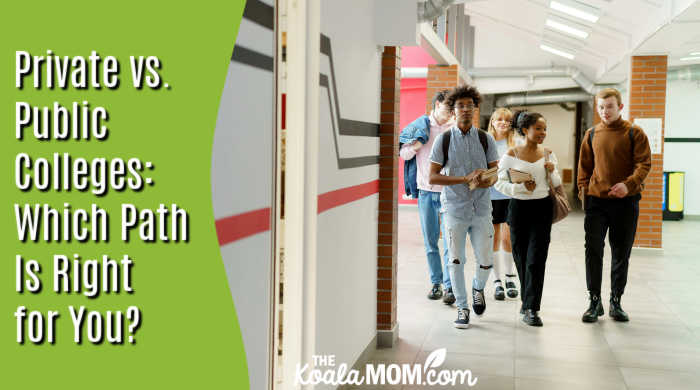The decision between attending a private or public college can significantly shape your academic experience and future career. Factors such as finances, campus culture, and available resources play a role in this choice. Understanding your goals, preferences, and needs (or your child’s) is critical when evaluating both institutions. While public colleges often offer lower tuition rates due to state funding, many private colleges boast smaller class sizes and personalized attention. Here’s a look into what each option offers and how to determine the most suitable path for your education.

Key Differences Between Public and Private Colleges
Public colleges typically receive funding from the government, allowing them to charge lower tuition fees for local residents. This financial aid model often makes public institutions more accessible to a larger group of students.
On the other hand, private colleges depend primarily on tuition and donations, leading to higher costs. However, many private institutions offer significant financial aid packages that can help offset these expenses. For example, student considering Berry College in Georgia may find that although tuition is more expensive upfront, financial aid may bring the costs closer to that of a public college. Ultimately, evaluating financial support and long-term debt is essential when making this choice.
I attended a small, private university whose cost was about 25% more than what some of my friends paid at a larger, public university in my same city. However, I had access to more bursaries at a smaller university. I was also competing with a smaller student group for the same government scholarships offered to all students, and that scholarship aided greatly with my tuition fees.
The academic environment can also differ significantly between public and private institutions. Public colleges often have a larger student body, which can realize a vibrant campus life but may lead to less individualized attention from professors. Conversely, private colleges usually provide smaller classes, fostering closer relationships with instructors and more hands-on learning opportunities. This difference can be crucial for students who thrive on personal feedback and close mentorship.
Campus Culture and Community
Campus culture is another vital aspect when choosing between public and private colleges. Due to their size, public colleges often cater to diverse student populations, leading to the emergence of a wide range of groups, activities, and interests. This diversity can enrich the college experience by exposing students to various perspectives and backgrounds. However, with this diversity, public institutions may lack a cohesive community, making it harder for students to connect on a deeper level.
In contrast, private colleges are generally smaller, allowing for a more intimate community. A close-knit environment often promotes stronger interpersonal relationships and shared values among students. This sense of belonging is attractive to many who prioritize collaboration and support during their academic journey. Many schools emphasize community service and leadership development, attracting students who wish to contribute positively to society. Understanding the campus culture that resonates with you can significantly shape your college experience.
If possible, spending a day as a guest student at prospective colleges can help give you a sense about the community there. How do other students interact with you as a new student? Often, universities pair prospective new students with a current student, who can answer questions about community, clubs, and more. When I spent a day as a student at the college that became my alma mater, I felt welcomed and at home there.
Academic Programs and Resources
Regarding academic programs, public colleges offer a broader catalog of majors and extracurriculars due to their larger size. They frequently have extensive research facilities, allowing students more opportunities to engage in various fields of study. However, some may argue that these many choices can lead to an overwhelming experience. Such vast offerings challenge finding a specific niche or interest.
Private colleges, on the other hand, may not have as many programs but often pride themselves on the quality of education and access to resources. With smaller student populations, elite faculty can dedicate more time to mentorship, providing students with unique engagement and support. Many private institutions focus on specific areas of study, offering specialized programs that prepare students for targeted career paths. Understanding the type of academic experience you desire is crucial to deciding between private and public options.
For example, even in high school, I knew that I wanted to be a writer “when I grew up.” However, the local colleges and universities did not offer a creative writing program. Choosing to stay at home for my post-secondary degree, I completed an English major instead. Later, as a mom, I attended the University of Victoria to complete a second degree with a major in Creative Writing. Sometimes I wish I had chosen to attend the larger university first, but I had a good experience with both of my degrees.
Post-Graduation Outcomes
The post-graduation success rate can also be a significant factor in choosing between private and public colleges. Public colleges often report strong job placement rates for their graduates, thanks to the vast network they have developed through years of alumni interactions and industry connections. These institutions frequently have substantial career services departments that help students navigate the job market, providing resources for internships, job applications, and networking events.
Despite smaller alum networks, private colleges often boast solid post-graduation outcomes due to the quality of education received and strong mentoring relationships. Graduates have well-developed skills and competencies, making them competitive candidates in the job market. Many private colleges maintain robust career services, focusing on personalized student support. Evaluating alum outcomes and resources available for job placement can provide vital insights into which college path may be best for your future.
The Best of Both
Another option for students is to start their degree at a smaller, private institution and then transfer to a larger, public institution to finish their degrees. Many universities offer transferable courses to enable students to do this. This can allow a student to access the individualized attention and smaller class sizes when they are doing their first-year classes (which tend to be larger classes at larger universities), and then to move into their chosen faculty in another university.
For example, several of my friends completed one or two years at the same private university that I attended, then transferred to the local university to complete their education degrees. Our smaller university only offered a degree in elementary education and they wanted to teach in high schools. While they had to carefully choose their courses to ensure that their courses were accepted by the university from which they graduated, they were able to enjoy the best of both private and public universities in completing their degrees.

Choosing between a public and private college ultimately rests on individual priorities and preferences. Factors such as financial considerations, desired learning environment, and future career aspirations all influence this decision. The ideal pathway aligns with your values, academic goals, and economic situation. You can find a college that best fits your educational and professional journey by carefully researching and reflecting on your priorities. Regardless of your decision, both paths have unique advantages and can lead to success.

No Responses Yet